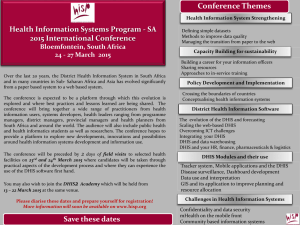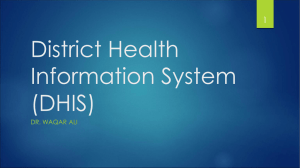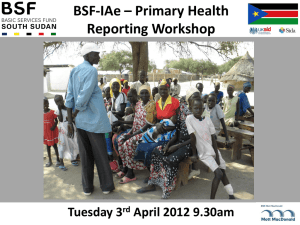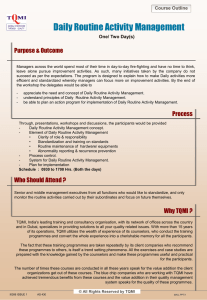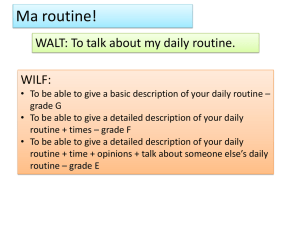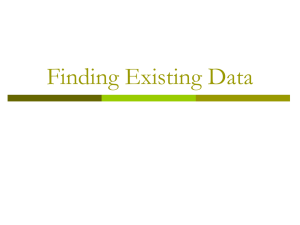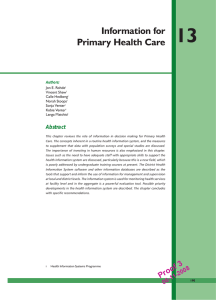Integrated Basic Health Services
advertisement
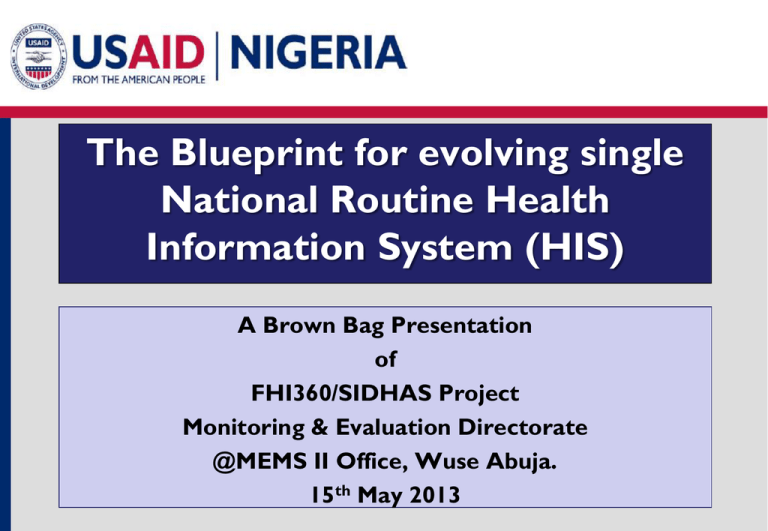
The Blueprint for evolving single National Routine Health Information System (HIS) A Brown Bag Presentation of FHI360/SIDHAS Project Monitoring & Evaluation Directorate @MEMS II Office, Wuse Abuja. 15th May 2013 Outline: • Rationale for this presentation • USG Health Portfolio structure and the NHSDP (2010 -2015) • The evolving National Routine Health data reporting system (DHIS) • Things to note • Suggested Blueprint • Take homes Rationale • To discuss the need, plausibility and the blueprint for single routine health Information System (HIS) in Nigeria USAID Public Health Portfolio Structure • HIV/AIDS and TB Team: is an integrated office that seek to improve access, coverage and sustainable capacity for HIV/AIDS and TB services in Nigeria – Assistance Objective 3: Increased Nigerian Capacity for a Sustainable HIV/AIDS and TB Response • Health, Population and Nutrition Team: is an integrated office that seeks to improve basic health services, HIV/AIDS, child survival, malaria, tuberculosis, population and maternal and child health and nutrition services. – Assistance Objective 4: Increased Use of High-Impact Health Interventions • The Biggest Assumption: Accurate and timely data to gauge the impact of the national response will be available. CDC Public Health Portfolio Structure • Strengthening Public Health Systems: provides technical leadership and direct assistance to strengthen epidemiology, surveillance, laboratory, blood safety, operations research, and workforce capacity—essential components for strong, sustainable public health systems. Institutionalize Nigeria HIVQual (NHIVQual) Establishment of National EMR Dataware house CDC Public Health Portfolio Structure • Development of National Medical Laboratory Strategic Plan National and International Accreditation of Medical Laboratories Establishment of a national reference lab for TB and other diseases • Establishment of Nigeria Center for Disease Control • The Biggest Assumption: Accurate and timely data to gauge the impact of the national response will be available. 6 GoN Health Portfolio USG Health Portfolio CSOs, CBO and Private Sector Health Portfolio What is USG’s Commitment? Data Source: 2011 Annual NHMIS Report Analysis of national routine health data reporting • PHCs accounts for 88% of the HFs in Nigeria. • If all PHCs report complete dataset, 88% national report is met. • Reporting from all PHCs is under the control of LGAs HMIS Officers. • LGA-led Integrated health data management approach can solve our problem. Table 1 Health Facilities in Nigeria by Type and Ownership, 2012 Ownership Type Total Public Private Primary 21808 8290 30098 (88%) Secondary 969 3023 3992 (12%) Tertiary 73 10 83 (0.002 %) Total 22850 11323 34173 Data Source: FMoH/DPRS 2012 Long History …… Unending Discussion 20miles: Connect US to China Port 22miles bridge : The Chinese sea bridge which will cut travel by 200 miles – US Mail Online What is the central purpose of strengthening the National Health Management Information System (NHMIS) ? 1. To make truly GoN-owned high quality routine health data available (from both the private and public sectors) and 2. To plan for and build sustainable NRHIS around the GoN structures and levels with expert TA and supportive supervision from all in-country-IPs. Principles & Context: • GHI Principles: • a new business model aimed at delivering dual objectives: • achieving significant health improvements • creating an effective, efficient and country-led platform for the sustainable delivery of essential health care and public health programs. (HIV/AIDS, Malaria, TB, INMCH, Nutrition, FP/RH, NTDs) • Third-Ones Principles: • One agreed country level Monitoring and Evaluation System. (M&E Framework for the NHSDP) Health Services & Routine Data Overview of Nigerian Health Data NHMIS Data Routine Health Data Nigerian Health Data Non-Routine Health Data (including Routine Surveillance) Disease Program Data – e.g. ATM Surveillance studies, Surveys, Operations Research, e.t.c What are we using Health Data/Information for in Nigeria: • Health Program Design & redesign, management Decision Making? • Health Policy Formulation and Development? • Health Planning and Budgeting? Initial Practice 10 HFs ------------PHCs Communities ------------------CHEWs • Basic Range Community of Health Health Services Services (100%) Range of Data Reporte d Referral Chain • Community NHMIS 20 HFs ------------GHs • • • 30 HFs ------------UTHs & FMCs Basic Health Services (100%) Facility NHMIS • • • Basic Health Services (30%) Specialized Healthcare Services (70%) • Facility NHMIS Disease Programs Report • • • Basic Health Services (10%) Specialized Healthcare Services (90%) Facility NHMIS Disease Programs Report Referral Chain Recent Shift • Range of Health Services Range of Data Reported HFs ------------GHs 10 HFs ------------PHCs Communities --------------- -CVs / CORPs/CBOs • • • Integrated Basic Health Screening & Services (100%) Integrated Health dataset Community NHMISplus • • 30 HFs ------------UTHs & FMCs 20 • Integrated Basic Health Services (30%) • Integrated Basic Health Services (10%) • Specialized & Integrated Healthcare Services (70%) • Specialized & Integrated Healthcare Services (90%) • Facility NHMISplus Disease Programs Report • Facility NHMISplus Disease Programs Report Integrated Basic Health Services (100%) Decentralized Special Services Facility NHMISplus • • Routine Health Services Databases Databases: Schematic Overview 2 (Proposed) DHIS 2.0: (Web-based Version) NHMIS NHMIS INMCH Disease Programs NTDs TB / HIV/AIDS / Malaria Nutrition FP/RH Hierarchical Organization of the Integrated Routine DHIS Platform Health Data ATM datasets HIV & AIDS dataset SRH/HIV Integration dataset Malaria dataset NHMIS dataset TB & TB/HIV dataset NPI dataset Epid. & Disease Surveillance dataset Central DHIS Instance National State State DHIS Instance LGA LGA DHIS Data Entry Hub Tertiary Facilities PHCs Secondary Facilities Community Facilities Can DHIS address the bigger picture about NHMIS? • • Legend: IT Programming codes • Align USG instance metadata with GoN DHIS instance Derive PEPFAR-NGIs from the data elements contained in the National MSFs Integrate Data Management Process at all levels. Current challenges: 1. Multiple DHIS platforms and its inter-operability & 2. Complicated data management process eNNRIMS DHIS Instance National HIV Response routine datasets (mainly from 20 and 30 Facilities) National DH&PRS DHIS Instance Development partners’ DHIS2.0 platform Project-level HIV/TB/Malaria and NHMIS routine datasets (mainly from 10, 20 and 30 Facilities) USG DHIS Instance USG HIV and TB Program routine datasets (mainly PEPFAR-NGIs from 10, 20 and 30 Facilities) Solution: Moving towards one national Integrated health data management system Community –level data LGAs PHCs data 20 HFs data National DH&PRS DHIS Instance 30 HFs data 1. GoN-led and driven data management system (sustainability) 2. Promote integrated health data management 3. One sole source for routine health data @ National, State and LGA-levels 4. Considers all-levels of health care including community. Suggested Blueprints • Confidence-building on GoN System’s ability to deliver timely routine health data if supported by Donors and IPs. • Address Institutional weaknesses and capacity constraints for functional HIS at Community-level, HFs, LGAs, State and National levels • Institutionalize LGAs Data Management team and data entry HUB approach – Strengthen our M&E system for better efficiencies and cost reduction – Advocate for IPs to unify tools, systems and processes for M&E. Deep Reflection! • The problem of M&E systems development in Nigeria is caused by IPs and their Donors! • The fragmentation in terms of M&E systems and processes is as a result of each IPs/Donors’ requirements. • If only M&E processes, systems and tools were unified, we will have a more organized system that produces timely and unified/harmonized program results. What are our fears about having One central HIS for routine health data in Nigeria? FEARS • Delayed access to routine data by stakeholders • Quality of what is coming through the Central HIS • Server Administration and • IT infrastructural capacity requirement (5,000+ Users in one Window) • Resource Coordination (Single funding basket) • Stakeholders’ Representative Data Management Team in place @ National level Is it likely to offer any cost saving measure on the long run? • Yes ! The cost of: – – – – HR need and capacity development for HIS management @ all level. IT Infrastructure and Maintenance Uninterrupted power supply Maintaining streamlined Data Management Systems, Processes and Operations such as: • Data Collection and Data Entry • Data Verification and Data Quality Assurance (DQA) and Change Management Process (CMP) Would this process have a chance for capacity transfer to the Government staff; leading to sustainability on the long run? • Yes! Through the: – Stakeholders’ Representative Data Management Team @ National level – Establishment of Integrated Data Management Team (GoN and IPs) at LGAs and State-level – Initial Joint Routine Supportive supervision and DQAs – Training of M&E practitioners for better results at the State and LGA levels. Thanks for Listening Lets Discuss
